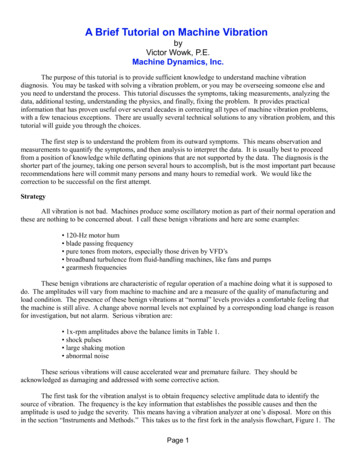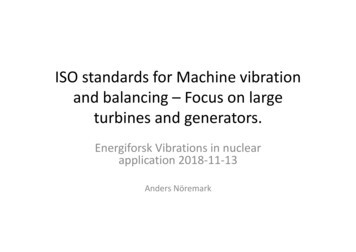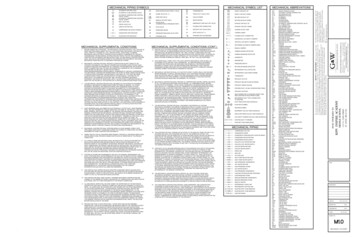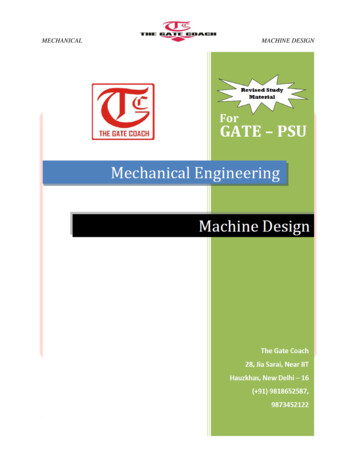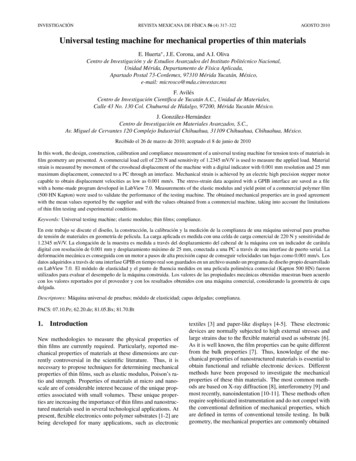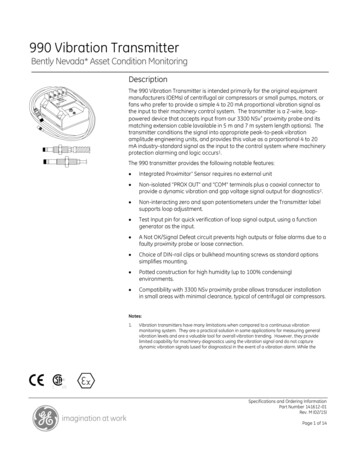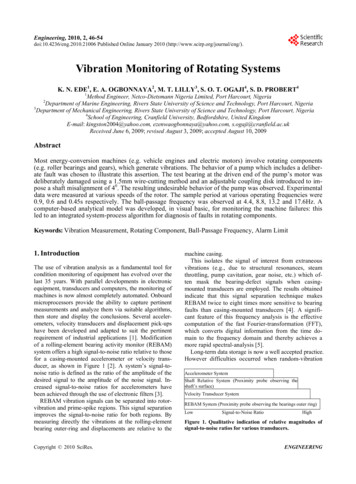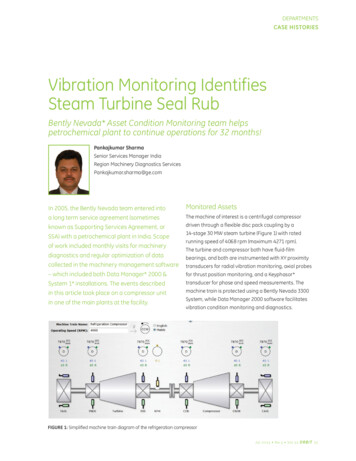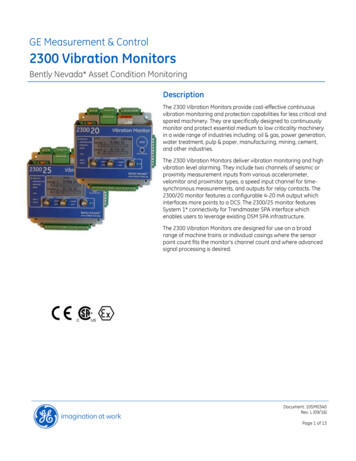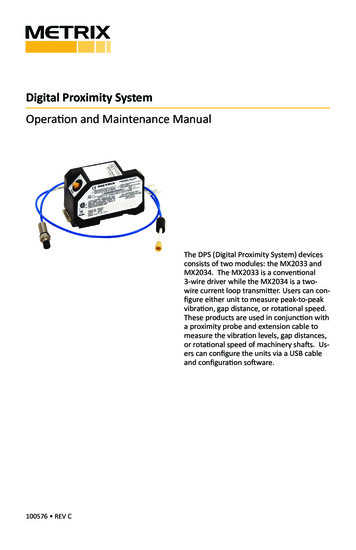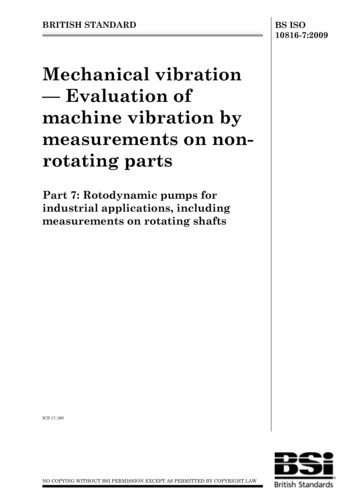
Transcription
BRITISH STANDARDMechanical vibration— Evaluation ofmachine vibration bymeasurements on nonrotating partsPart 7: Rotodynamic pumps forindustrial applications, includingmeasurements on rotating shaftsICS 17.160NO COPYING WITHOUT BSI PERMISSION EXCEPT AS PERMITTED BY COPYRIGHT LAWBS ISO10816-7:2009
BS ISO 10816-7:2009National forewordThis British Standard is the UK implementation of ISO 10816-7:2009.The UK participation in its preparation was entrusted to TechnicalCommittee GME/21/5, Vibration of machines.A list of organizations represented on this committee can be obtained onrequest to its secretary.This publication does not purport to include all the necessary provisionsof a contract. Users are responsible for its correct application.Compliance with a British Standard cannot confer immunityfrom legal obligations.This British Standardwas published under theauthority of the StandardsPolicy and StrategyCommittee on 31 March2009 BSI 2009ISBN 978 0 580 57438 2Amendments/corrigenda issued since publicationDateComments
INTERNATIONALSTANDARDBS ISO 10816-7:2009ISO10816-7First edition2009-02-01Mechanical vibration — Evaluation ofmachine vibration by measurements onnon-rotating parts —Part 7:Rotodynamic pumps for industrialapplications, including measurements onrotating tions mécaniques — Évaluation des vibrations des machines parmesurages sur les parties non tournantes —Partie 7: Pompes rotodynamiques pour applications industrielles, ycompris mesurages sur les arbres tournantsReference numberISO 10816-7:2009(E) ISO 2009
BS ISO 10816-7:2009ISO 10816-7:2009(E)PDF disclaimerThis PDF file may contain embedded typefaces. In accordance with Adobe's licensing policy, this file may be printed or viewed butshall not be edited unless the typefaces which are embedded are licensed to and installed on the computer performing the editing. Indownloading this file, parties accept therein the responsibility of not infringing Adobe's licensing policy. The ISO Central Secretariataccepts no liability in this area.Adobe is a trademark of Adobe Systems Incorporated.Details of the software products used to create this PDF file can be found in the General Info relative to the file; the PDF-creationparameters were optimized for printing. Every care has been taken to ensure that the file is suitable for use by ISO member bodies. Inthe unlikely event that a problem relating to it is found, please inform the Central Secretariat at the address given IGHT PROTECTED DOCUMENT ISO 2009All rights reserved. Unless otherwise specified, no part of this publication may be reproduced or utilized in any form or by any means,electronic or mechanical, including photocopying and microfilm, without permission in writing from either ISO at the address below orISO's member body in the country of the requester.ISO copyright officeCase postale 56 CH-1211 Geneva 20Tel. 41 22 749 01 11Fax 41 22 749 09 47E-mail copyright@iso.orgWeb www.iso.orgPublished in Switzerlandii ISO 2009 – All rights reserved
BS ISO 10816-7:2009ISO 10816-7:2009(E)ContentsPageForeword .ivIntroduction.v1Scope .12Normative references.23Vibration measurement.24Vibration evaluation .75Evaluation zones and conditions for operation in situ and acceptance tests.86Operational limits .9Annex A (normative) Evaluation zone limits for vibration of non-rotating parts .11Annex B (informative) Evaluation criteria for relative shaft vibration of rotodynamic pumps withsleeve bearings.13Annex C (informative) Example of setting ALARM and TRIP values.15Annex D (informative) Consideration of support flexibility and installation xw.com ISO 2009 – All rights reservediii
BS ISO 10816-7:2009ISO 10816-7:2009(E)ForewordISO (the International Organization for Standardization) is a worldwide federation of national standards bodies(ISO member bodies). The work of preparing International Standards is normally carried out through ISOtechnical committees. Each member body interested in a subject for which a technical committee has beenestablished has the right to be represented on that committee. International organizations, governmental andnon-governmental, in liaison with ISO, also take part in the work. ISO collaborates closely with theInternational Electrotechnical Commission (IEC) on all matters of electrotechnical standardization.International Standards are drafted in accordance with the rules given in the ISO/IEC Directives, Part 2.The main task of technical committees is to prepare International Standards. Draft International Standardsadopted by the technical committees are circulated to the member bodies for voting. Publication as anInternational Standard requires approval by at least 75 % of the member bodies casting a vote.Attention is drawn to the possibility that some of the elements of this document may be the subject of patentrights. ISO shall not be held responsible for identifying any or all such patent rights.ISO 10816-7 was prepared by Technical Committee ISO/TC 108, Mechanical vibration, shock and conditionmonitoring, Subcommittee SC 2, Measurement and evaluation of mechanical vibration and shock as appliedto machines, vehicles and structures, in collaboration with ISO/TC 115 Pumps.ISO 10816 consists of the following parts, under the general title Mechanical vibration — Evaluation ofmachine vibration by measurements on non-rotating parts:www.bzfxw.com Part 1: General guidelines Part 2: Land-based steam turbines and generators in excess of 50 MW with normal operating speeds of1 500 r/min, 1 800 r/min, 3 000 r/min and 3 600 r/min Part 3: Industrial machines with nominal power above 15 kW and nominal speeds between 120 r/min and15 000 r/min when measured in situ Part 4: Gas turbine sets with fluid-film bearings Part 5: Machine sets in hydraulic power generating and pumping plants Part 6: Reciprocating machines with power ratings above 100 kW Part 7: Rotodynamic pumps for industrial applications, including measurements on rotating shaftsiv ISO 2009 – All rights reserved
BS ISO 10816-7:2009ISO 10816-7:2009(E)IntroductionVibration measurements on rotodynamic pumps can be useful for many purposes, e.g. for the operationalmonitoring, acceptance test and for diagnostic or analytic investigation (condition monitoring).General descriptions of the principles to be applied for the measurement and assessment of vibration oncoupled industrial machines are given for vibration on non-rotating parts in ISO 10816-1 and for shaft vibrationin ISO 7919-1.This part of ISO 10816 is based on vibration data gathered from a survey of about 1 500 pumps operatingboth in situ and at various test facilities. This survey included pumps of different types, speed and power,operating over a wide range of flows. Due to the large number of vibration measurements, these data areconsidered to be representative of pumps that are operating satisfactorily, though there is a lack of informationabout the mean time between failure and operating conditions for the measured values.Statistical evaluation of these data has been made for the preferred operating region, i.e. 70 % to 120 % of thebest efficiency point (BEP), as well as evaluations of the flow and power dependency.This vibration survey showed no significant differences between rigid and flexible supports, or betweenhorizontal and vertical orientations of the pumps when measured at the positions defined in this part ofISO 10816. This is in contrast to other standards dealing with vibration measurements (e.g. ISO 10816-1,ISO 10816-3 and ISO 13709 [10]) which do make these ��The statistical analysis showed a slight dependency of the vibration values with the power consumption of apump. Consequently, this part of ISO 10816 distinguishes between pumps up to and above 200 kW. ISO 2009 – All rights reservedv
BS ISO �
BS ISO 10816-7:2009INTERNATIONAL STANDARDISO 10816-7:2009(E)Mechanical vibration — Evaluation of machine vibration bymeasurements on non-rotating parts —Part 7:Rotodynamic pumps for industrial applications, includingmeasurements on rotating shafts1ScopeThis part of ISO 10816 gives instructions for the evaluation of vibration on rotodynamic pumps for industrialapplications with nominal power above 1 kW. It defines the special requirements for evaluation of vibrationwhen the vibration measurements are made on non-rotating parts (bearing housing vibration). It providesspecific guidance for assessing the severity of vibration measured on bearing housings of rotodynamic pumpsin situ and for the acceptance test at the manufacturer’s test facility or in the plant. This part of ISO 10816 alsogives general information and guidelines for assessing relative shaft vibration of the rotating shaft.This part of ISO 10816 specifies zones and limits for the vibration of horizontal and vertical pumps irrespectiveof their support flexibility. The general evaluation criteria are valid for operational monitoring of rotodynamicpumps and for acceptance tests1) in situ or at the manufacturer’s test facility if specified. For the acceptancetest at the manufacturer’s test facility, special conditions are given.www.bzfxw.comFor monitoring the vibration values during long-term operation, two criteria are provided for assessing themachine vibration. One criterion considers the magnitude of the observed vibration and the second considerschanges in magnitude. The evaluation criteria are applicable for the vibration produced by the pump itself andnot for vibration which is transmitted to the pump from external sources. The criteria mainly serve to ensure areliable, safe long-term operation of the pump, simultaneously minimizing harmful effects on connecteddevices. Additionally, recommendations are given for defining operational limits and setting alarm and tripvalues.For pump units with integrated electrical motors (impeller directly on the motor shaft or impeller shaft rigidlyconnected to the motor shaft), this part of ISO 10816 applies to the whole coupled unit.For flexibly coupled motors, this part of ISO 10816 is applicable for the pump only. Also, separately mounteddrivers are not within the scope of this part of ISO 10816. Those drivers are dealt with in ISO 10816-3.The following types of pumps are excluded from this part of ISO 10816: reciprocating and rotating positive displacement pumps; reciprocating engine driven pumps;1) Wherever acceptance tests are mentioned in this part of ISO 10816 it should be taken into account that all the detailsabout place, size and form of those test procedures are optional and need to be specified and agreed between bothparties of a contract. ISO 2009 – All rights reserved1
BS ISO 10816-7:2009ISO 10816-7:2009(E) pumps in hydraulic power generating and pumping plants with power above 1 MW (see ISO 7919-5 [4]and ISO 10816-5); solids handling, slurry and submersible pumps.Torsional vibration is not dealt with in this part of ISO 10816.2Normative referencesThe following referenced documents are indispensable for the application of this document. For datedreferences, only the edition cited applies. For undated references, the latest edition of the referenceddocument (including any amendments) applies.ISO 2954, Mechanical vibration of rotating and reciprocating machinery — Requirements for instruments formeasuring vibration severityISO 7919-1, Mechanical vibration of non-reciprocating machines — Measurements on rotating shafts andevaluation criteria — Part 1: General guidelinesISO 10816-1:1995, Mechanical vibration — Evaluation of machine vibration by measurements on non-rotatingparts — Part 1: General guidelines3Vibration measurement3.1Measurement quantity and e measurement quantity to be used for measuring the vibration of non-rotating parts 2) of rotodynamicpumps is the root-mean-square (r.m.s.) vibration velocity in mm/s. For speeds below 600 r/min, it isadditionally required to measure the peak-to-peak displacement in µm. The measurement procedure to befollowed is specified in ISO 10816-1.3.2Measuring instrumentation and frequency range3.2.1GeneralThe measuring instrumentation shall conform to the requirements set out in ISO 10816-1. The instrumentationshall be capable of measuring the r.m.s. vibration velocity in a broad frequency range reaching from at least10 Hz to 1 000 Hz and shall be in accordance with the requirements of ISO 2954.For pumps with operating speeds below 600 r/min, the lower frequency limit of the measuring instrume
BS ISO 10816-7:2009 National foreword This British Standard is the UK implementation of ISO 10816-7:2009. The UK participation in its preparation was entrusted to Technical Committee GME/21/5, Vibration of machines. A list of organizations represented
